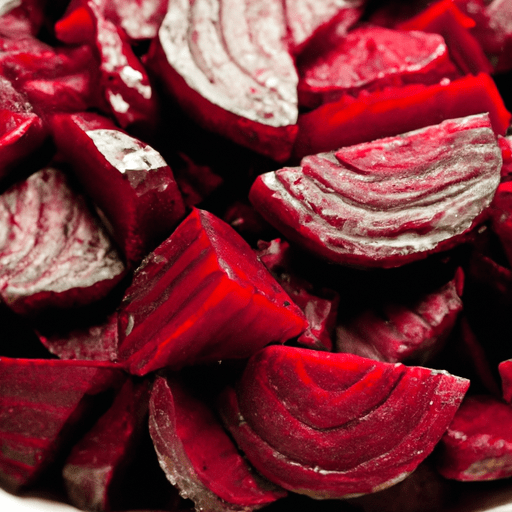The Versatile Canned Beet: A Gem in the Pantry
Canned beets may not always receive the attention they deserve in the culinary world, but it’s time we shed light on these ruby gems hiding in your pantry. They offer a burst of vibrant color, earthy flavor, and a wide array of culinary possibilities. In this blog post, we’ll dive into the delicious taste, various uses in cooking, nutritional benefits, and even a few historical tidbits about these versatile canned beets.
Tasting Nature’s Sweetness
When you first crack open a can of beets, you’re met with a rich, sweet aroma that immediately piques your senses. Their taste is earthy and slightly tangy, with a natural sweetness that sets them apart from other root vegetables. This unique flavor profile adds depth and complexity to a variety of dishes, making canned beets an alluring ingredient for both sweet and savory creations.
A Multitude of Culinary Possibilities
Canned beets are incredibly versatile and can be used in numerous culinary applications. Here are a few popular ways to incorporate them into your cooking:
1. Salads:
Canned beets, when thinly sliced or cubed, can be added to salads, bringing a burst of color and flavor. They pair wonderfully with fresh greens, creamy cheeses like feta or goat cheese, citrus fruits, and even nuts or seeds for added texture.
2. Soups and Stews:
The natural sweetness and earthy flavor of canned beets lend themselves beautifully to hearty soups and stews. They add depth to broths, provide a vibrant color, and their tender texture integrates seamlessly with other ingredients.
3. Side Dishes:
Canned beets can also be transformed into delightful side dishes. They can be pickled to create tangy beet pickles or mashed together with other root vegetables to create a creamy and colorful puree.
4. Baked Goods:
While it may sound unusual, canned beets can be pureed and used in baked goods like cakes, muffins, and brownies. This unexpected addition adds moisture, natural sweetness, and an appealing red hue to your treats.
Nutritional Benefits
Apart from their delightful taste and culinary versatility, canned beets are also a nutritional powerhouse. Packed with essential vitamins, minerals, and fiber, they offer an array of health benefits. Here are a few noteworthy nutritional components found in canned beets:
- Antioxidants: Canned beets are a rich source of antioxidants, including betalains, which fight inflammation and protect against chronic diseases.
- Fiber: They provide dietary fiber, aiding digestion, regulating blood sugar levels, and promoting satiety.
- Vitamins and Minerals: Canned beets are a good source of vitamin C, folate, potassium, and manganese.
Historical Tidbits
Beets have a fascinating history that dates back centuries. The ancient Romans were known to consume beets and used them for medicinal purposes. However, it wasn’t until the 19th century that beets gained more recognition as a culinary ingredient. Canned beets became increasingly popular during the early 20th century as a convenient way to enjoy the vegetable year-round.
Canned beets may not be the most talked-about ingredient in the culinary world, but they offer a vibrant color, unique taste, and a variety of uses in both sweet and savory dishes. Whether you’re looking to add a pop of color to a salad, create a wholesome soup, or explore the unexpected by using them in baked goods, canned beets are a valuable addition to any pantry. So, don’t overlook these humble canned gems - embrace their versatility and take your cooking to new heights!
Canned Beets
Origin: Beets, scientifically known as Beta vulgaris, are believed to have originated from the Mediterranean region. They have been cultivated for thousands of years and were highly prized by ancient civilizations such as the Greeks and Romans.
Common Uses: Canned beets are widely used in various culinary applications. They can be enjoyed as a side dish on their own or used in salads, soups, stir-fries, and even desserts. Canned beets are also sometimes used to make beet juice or incorporated into smoothies for their vibrant color and earthy flavor.
Nutritional Benefits: Canned beets are a good source of essential nutrients. They are particularly high in folate, manganese, and potassium. Additionally, beets contain dietary fiber, vitamin C, iron, and antioxidant compounds such as betalains, which may have potential health benefits.
Unique Properties: Beets are known for their vibrant, deep red color, which comes from pigments known as betalains. These pigments are water-soluble and can leach out if overcooked or exposed to excessive heat. Consequently, canned beets may lose some of their vibrant color compared to fresh beets, though they still retain much of their nutritional value.
Historical Significance: Beets have a rich historical significance. In ancient times, they were used both for their roots and their leaves. The ancient Romans and Greeks cultivated them not only for food but also for medicinal purposes. Beets were later brought to Europe during the expansion of the Roman Empire and became an important part of European cuisine.
These facts provide an overview of canned beets, including their origin, common uses, nutritional benefits, and unique properties. Understanding these facts can help in appreciating the cultural significance and culinary versatility of this ingredient.




Use the share button below if you liked it.
It makes me smile, when I see it.